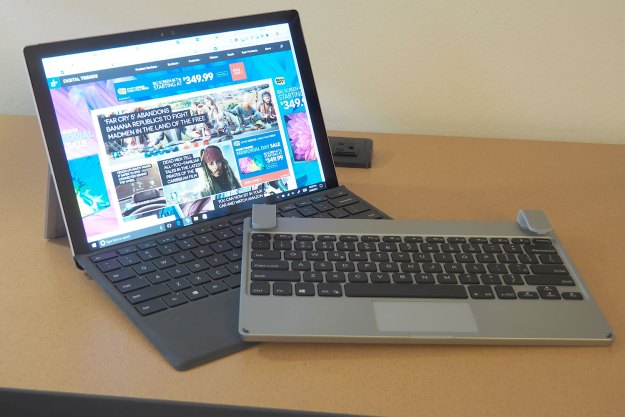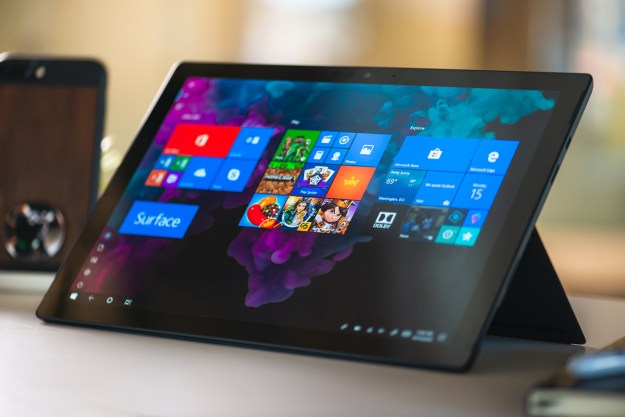
“The Brydge 12.3 aspires to turn the Surface Pro into a real notebook, but a mediocre keyboard and touchpad hold it back.”
- Durable, attractive design
- Provides a more stable base than the Type Cover
- Keyboard is mediocre and too stiff for comfortable typing
- Touchpad is small and needs some polish -- literally
- Doesn’t improve typing over the Type Cover
While the Surface Pro line has a great portable keyboard in its Type Cover, some struggle with the “lapability” of the Surface Pro when the Type Cover is attached. Simply put, most detachable tablets suffer from some instability when used in situations other than sitting on a flat surface, and the poor lapability of the Surface Pro remains a sore spot for many. The built-in kickstand just doesn’t work on a lap.
That’s where the Brydge 12.3 keyboard dock comes in. It’s an accessory that’s designed specifically to turn the Surface Pro into a more traditional clamshell notebook. Pop a Surface Pro into the Brydge 12.3, the idea goes, and it gains instant lapability. The Surface Pro 3, Pro 4, and Pro (2017) are all supported.
Sounds great, right? The Brydge 12.3 is $150, however, making it yet another accessory that adds the Surface’s already expensive price. Let’s see if it’s worthwhile.
A solid build that provides some real stability
Brydge, creator of the dock, did a great job of ensuring the Brydge 12.3’s connection to the Surface Pro is both solid and attractive. The Brydge 12.3 is constructed from a chunk of solid aluminum and is a close enough match for the Surface Pro’s machined magnesium. It’s sized to cover the Surface Pro completely, folding into a clamshell form factor with rubber stoppers to keep the display safe from scratches.
The Brydge 12.3 is a dense accessory that weighs a hefty 1.48 pounds, which comes close to doubling the Surface Pro’s weight. That’s a good thing, because the weight balances the tablet, and keeps it stable in use. As a result, the Brydge 12.3 lives up to its billing in the lapability department.
The Surface Pro connects to the Brydge 12.3 via the company’s patented hinge, with rubberized clamps that grip the tablet when it’s pushed into the hinges’ grooves. Out of the box, the Brydge 12.3 supports the new Surface Pro and the Surface Pro 4, and an included set of hinge pads can be swapped in to support the Surface Pro 3.
The hinge is easy to open and close, with enough stability to keep the tablet in the preferred position from zero degrees (closed) to 160 degrees. The keyboard does close very quickly when it reaches a certain point, so care should be taken when closing things up.
One strike against the Brydge 12.3 is that inserting and removing the Surface Pro requires some effort. That’s good in terms of keeping the tablet in place, but it makes removing the device for tablet use a real pain.
Pairing is easy and reliable
The Brydge 12.3 connects to the Surface Pro via Bluetooth 3.0. Pairing was easy enough, and a solid connection was maintained throughout our testing. In addition, we experienced little of the lag that sometimes occurs with Bluetooth keyboards. The Brydge 12.3 uses AES encryption, which is a nice privacy touch if you’re worried about having your keystrokes intercepted.
The Brydge includes a battery that recharges via micro-USB cable. An AC adapter isn’t included, and so you’ll have to provide your own, or use one of the many USB ports you already own. The company expects the keyboard to last around three months on a charge. A key press provides an indication of remaining battery life.
A decent typing experience, but a disappointing touchpad
The Brydge 12.3 features a full-size keyboard with all the usual function keys. Key travel felt more than sufficient. However, the keys were stiff, and required a bit too much force to depress, which might be fatiguing over long typing sessions.
The touchpad is the Brydge 12.3’s weakest feature.
Keyboard backlighting is supported, and while not exceptionally bright, we thought it perfect for use in a dark room.
The touchpad is the Brydge 12.3’s weakest feature. It’s the smallest touchpad we’ve used on a device in recent memory, smaller even than that on the Surface’s Type Cover. That seems an odd decision. Brydge’s keyboard is supposed to make laptop use better. Its responsiveness, feel, and accuracy are fine, with limited gesture support, and usable-yet-stiff buttons.
However, using the touchpad feels like navigating a 12.3-inch display using a postage stamp. Worse, the touchpad is recessed into the keyboard, so our fingers tended to bang up against the edges.
Warranty information
The Brydge 12.3 comes with a one-year hardware warranty.
Our Take
The Brydge 12.3 is a solidly built keyboard dock for the Surface Pro that fits tightly to create an attractive and stable clamshell notebook. The keyboard is only average, however, and the touchpad is simply too small.
Is there a better alternative?
Microsoft’s Type Cover provides a more comfortable typing experience, and its touchpad is significantly better. You might not like using the Surface Pro and Type Cover combination on your lap, but you might be more productive.
Both are priced similarly at $130 for the standard Type Cover, and $150 for the new Premium version. You’ll pay $150 for the Brydge 12.3. That makes it hard to recommend the Brydge unless you really need to use your Surface Pro on your lap with perfect stability.
How long will it last?
The Brydge 12.3 works with the last three generations of the Surface Pro, but there’s no guaranteed that it will fit then next version. It’s obviously built to last, so there’s good reason to believe it will work for as long as you have your current Surface Pro, but there’s no guarantee.
Should you buy it?
It’s difficult to recommend the Brydge 12.3 given its poor touchpad experience. You could use it with an external mouse and have a workable solution, but then again, you’re more likely to use a mouse on a desktop that’s stable enough for the standard Type Cover, rendering the Brydge 12.3 unnecessary.
Editors' Recommendations
- Oppo’s Android 12-based ColorOS 12 is coming to the Find X3 Pro in December
- Windows 10 can run better virtualized on Apple’s M1 Macs than on Surface Pro X
- The Surface Book 3 might have room for a touchscreen in the keyboard deck
- The Microsoft Surface Pro X has 3 times the performance than the Pro 6
- Images spoil Microsoft’s surprise, reveal Surface Pro 7, 15-inch Surface Laptop






